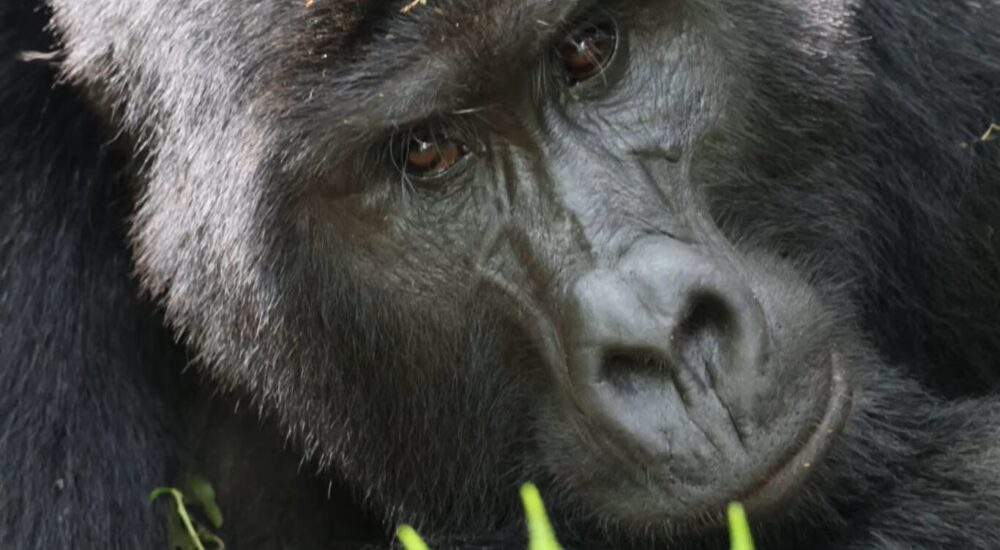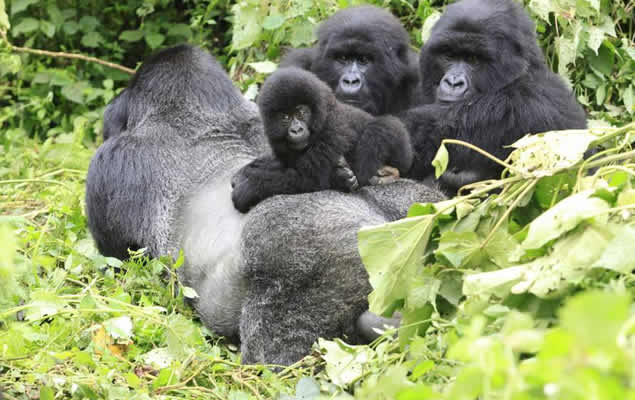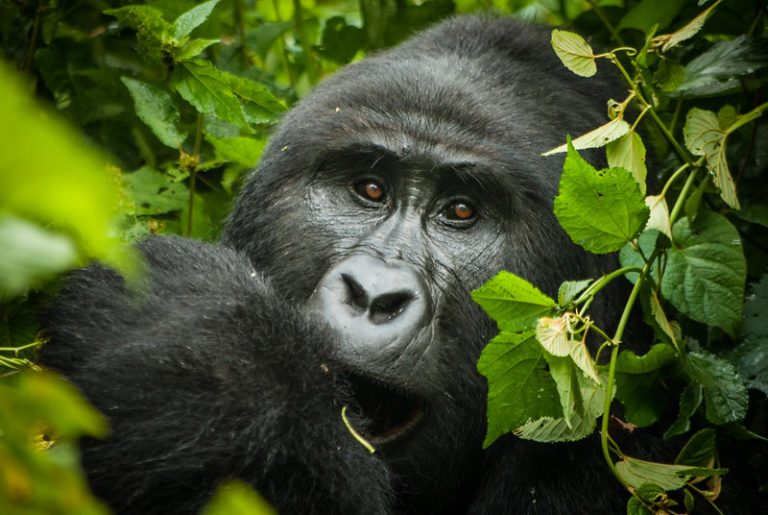What is Gorilla Trekking? Best Destinations for Family-Friendly Gorilla Trekking Preparing for Your Gorilla…
Facts about Mountain Gorilla Diet
Facts about Mountain Gorilla Diet, Because mountain gorillas are so close to people and are in danger, it makes you wonder what they eat to be so strong. Another reason people want to know what mountain gorillas eat is that they don’t do well in zoos.
Volcanoes National Park in Rwanda, Bwindi Impenetrable National Park in Uganda, and Mgahinga Gorilla National Park in the Democratic Republic of the Congo are all places where you can find mountain gorillas. They need a lot of food because they are the biggest primates in the world, and most of what they eat are plants. About 142 types of plants are known to be eaten by mountain gorillas. Leaves, shoots, and stems make up more than 86% of their food.
7% of their food is roots that they can eat, 3% is flowers, and 2% is fruits. It is very hard for mountain gorillas to eat fruit because they live so high up. Lowland gorillas, on the other hand, eat mostly fruit. There are two main kinds of gorillas, and each species has two subspecies. Cross River gorillas and Western Lowland gorillas are the two types of western gorillas. It has two subspecies: mountain gorillas and eastern lowland gorillas. The eastern gorilla is a species of gorilla.
What do gorillas eat?
As eaters, gorillas eat mostly green plants like grasses, herbs, roots, leaves, bamboo shoots, fruits, and the bark and stems of trees and shrubs. Gorillas also eat ash and dirt to keep their digestive systems in check, neutralize the dangerous chemicals in some of the plants they eat, and get nutrients that aren’t found in the plants they eat.
In order to get energy, they also eat bugs like termites, ants, snails, caterpillars, and others. People also say that mountain gorillas eat ants, snails, and grubs sometimes; this makes up 2% of their food. Going alone, mountain gorillas don’t drink water because they are afraid of it. For mountain gorillas, most of the water they need comes from the leaves and stems they eat every day. At least this way, they get a balanced meal.
There are some differences between mountain and lowland gorillas in terms of size and diet. Mountain gorillas are a bit smaller than lowland gorillas. They mostly eat plants because they live in rain forests that are high up and don’t have a lot of fruit trees. Lowland gorillas, on the other hand, are bigger and mostly eat fruits.
When it’s dry, the fruits fall off fast, so they get used to it by climbing up trees to get the fruits. Sometimes they have to eat a lot of seeds and tree barks to stay alive. The rainforests of Africa are home to more than 142 different plant species that mountain gorillas eat. Leaves, stems, and bamboo shoots make up about 86% of their food, while edible roots make up 7%, flowers 3%, fruits 2%, and ants, grubs, and snails 2%.
What Mountain Gorillas Eat: Facts
Like humans, gorillas have 32 teeth that they use to chew and digest the plants they eat. However, when they reach adulthood, adult gorillas get long, pointy canines that they use to fight other male gorillas. A male gorilla adult eats about 30 kilograms of plants every day, while a female gorilla adult eats about 18 kilograms of plants every day. Mountain gorillas don’t drink much water because the leaves they eat are so soft, tasty, and juicy that they store and provide half of the water they need to stay alive. They also get water from the mist in the morning.
Mountain gorillas are selective eaters; they don’t eat all the plants in one area. Instead, they eat the roots of one plant, the stems of another, the leaves of another, and so on. This lets the plants they were eating grow back because they keep moving from one place to another. Every day, gorillas can travel up to six kilometers in search of food. They can also move from one place to another.
Gorillas talk to each other by making about 25 different sounds, such as roars, cries, grunts, screams, growls, hoots, and their distinctive chest beats. Gorillas talk to each other when they want to get food, show pain, help each other, and other things. Gorillas are herbivores that get all of their food, housing, and fruits and vegetables from the plants they live in. Still, these are important for their existence.
Female gorillas start giving birth between the ages of 10 and 12; their pregnancies last 8.5 months, and they have one baby every two to three years, for a total of 4 to 6 babies. This makes it hard for the population to grow, which in turn makes it hard for the gorilla population to grow.
Gorilla babies can weigh up to four kilograms when they are born. They feed on breast milk for five months, and their moms feed them once an hour until they are four years old. Gorilla males are 5 to 9 feet tall and weigh between 136 and 196 kilograms. Gorilla females are 5 feet tall and weigh between 68 and 113 kilograms.
What do Mountain Gorillas do to get food?
There is no bigger or stronger ape than a mountain gorilla. They use their enormous strength to cut plants into pieces so they can eat the part they want. It is important for gorillas to have a specific ecological niche because they are very picky eaters and don’t eat all the plants in the area where they feed. They move from one place to another all the time so that plants can grow new leaves. Because of the way they eat, they may be refilled quickly.
Mountain gorillas are picky eaters who only eat certain parts of plants. One plant’s base, another plant’s stem, another plant’s leaves and fruit, and so on, are the only things they might eat.
How much do Mountain Gorillas eat?
Every day, an adult mountain gorilla eats about 27 kilograms of food. This is because they have big bodies that need more food to keep them going. The things gorillas do most of the time are eat or look for food. Early in the morning, they leave the places where they slept the night before and search the bush for a good place to eat and rest. The silverback gorilla is in charge of leading the family or group to a good place with enough food for everyone.
One meal a day in the morning and another at night. The kids will play with each other, and the adults will relax in between meals. Gorillas don’t eat too much in one place before going on to another. They pick the shoots, buds, roots, leaves, and stems and collect them very carefully so they don’t hurt the plants they eat.
A beautiful example of this is how a gorilla will not eat the roots of the same plant that it just ate the leaves or buds of. Instead, it will look for the roots of a different species that is close. Mountain gorilla families each have their own “zone.” Going into the territory of another group is rare and can lead to fights as the silverback protects his own family.
Do Mountain Gorillas have regular times to eat?
Because gorillas selectively eat, which leads to good eating habits, Mountain gorillas don’t eat too much and destroy one part of the forest while they are feeding. Because they are getting the right amount of food, the plants may soon grow again. The leaves, shoots, and roots of a plant are all that mountain gorillas eat. They then move on to another plant to eat a different part. These are the ways that mountain gorillas eat, and they are also very smart about how they store their food.
What do Mountain Gorillas eat?
Even though all scientists agree that gorillas are omnivores because they sometimes eat bugs like termites, they don’t eat meat or fish. To protect themselves, they use their strong bite to fight other animals and to chew on veggies.
What do Mountain Gorillas eat when they’re out in the wild?
In the wild, mountain gorillas and other types of gorillas don’t eat bananas, even though they are able to. The main reason is that they can’t find bananas in the wild. Bananas can’t grow in the bush where gorillas live because there are too many trees. Because of this, most gorillas that live in the wild never see or eat a banana in their whole lives.
When is the best time to see wild Mountain Gorillas?
Visitors can see gorillas at any time of the year, but the best time is during the dry season, which is June, July, August, September, December, January, and February. During this time, there is less rain, making the trails drier, and it easier to see the gorillas because the trees aren’t as full of leaves. The wet season, from March to May and October to November, has rain, making the trails slippery and muddy, and it’s harder to see the gorillas.


